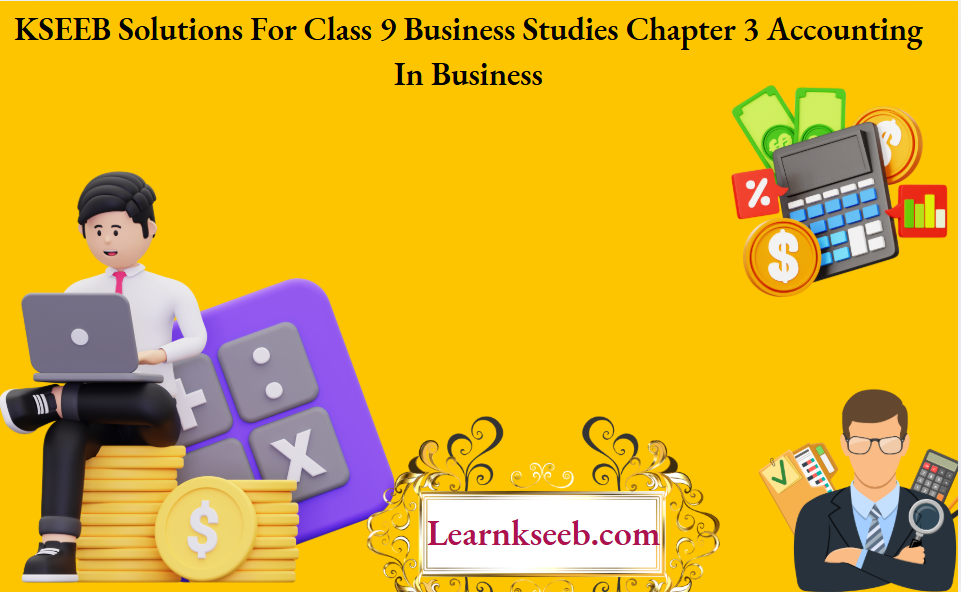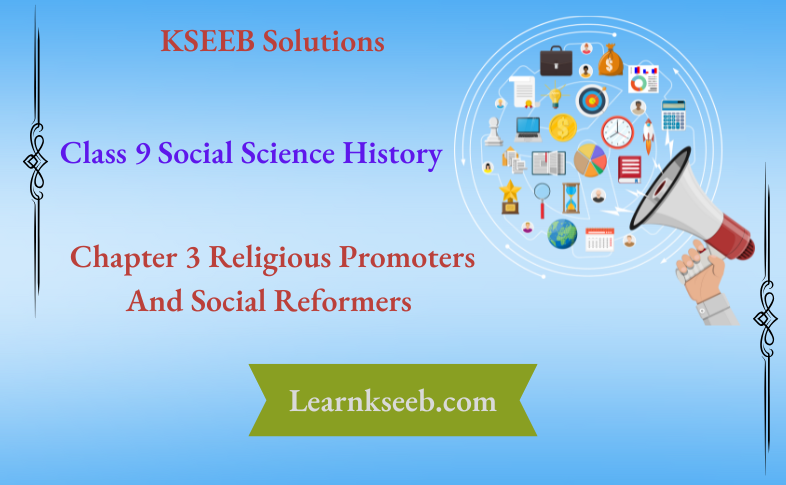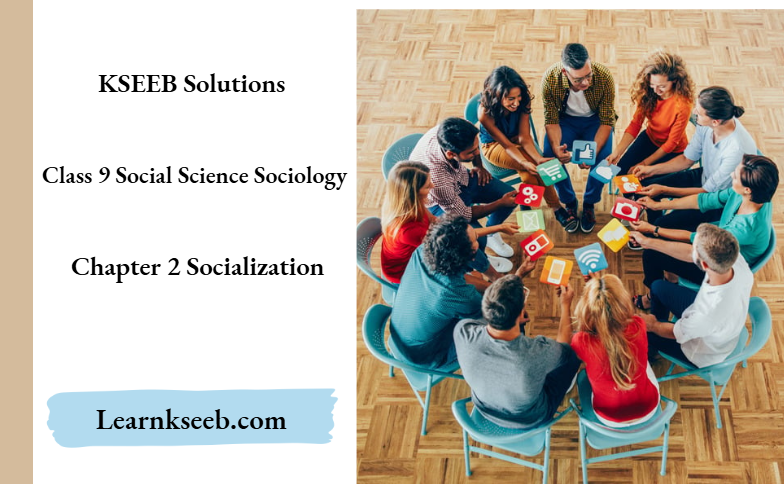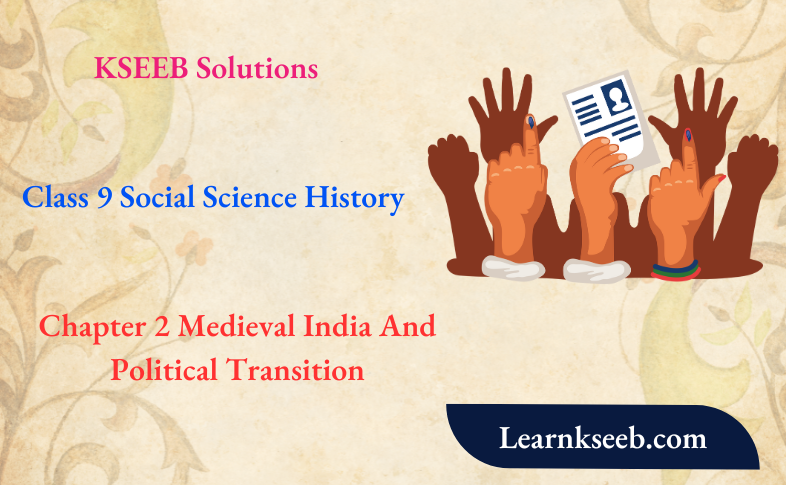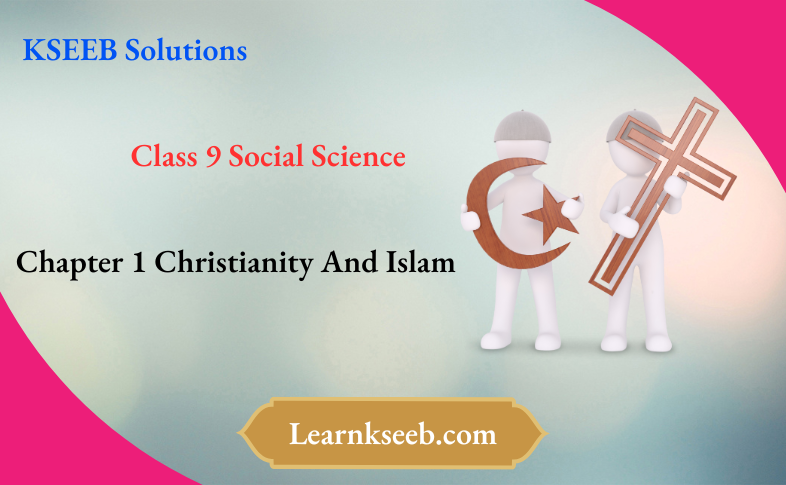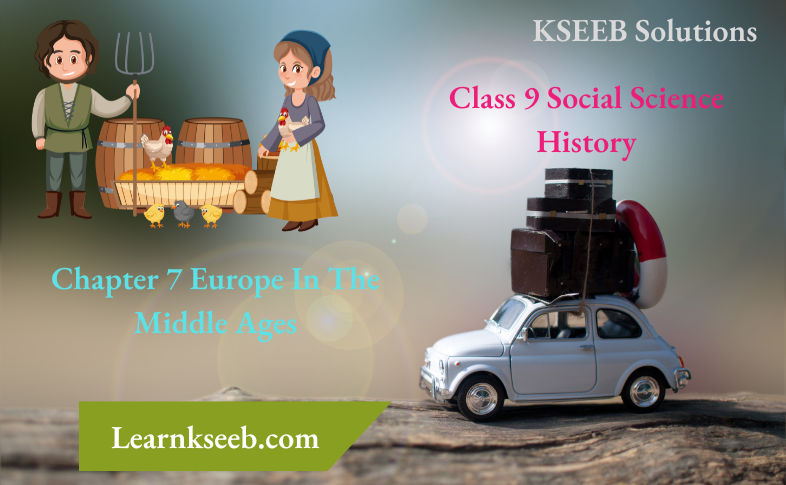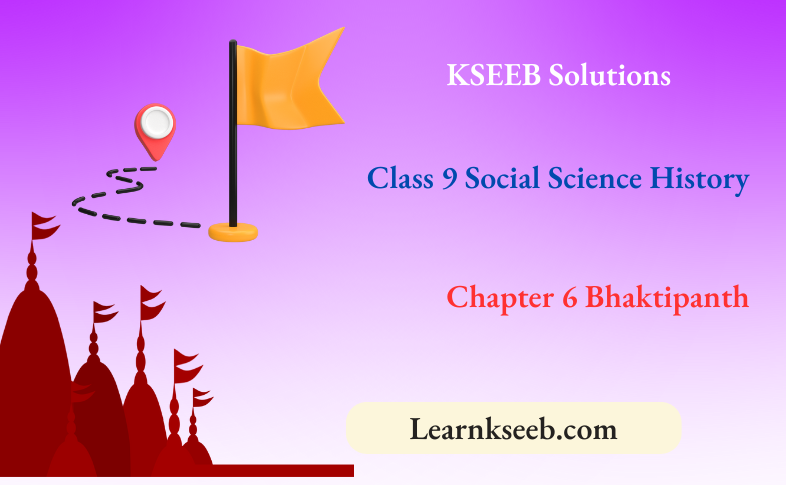KSEEB Solutions For Class 9 Social Science History Chapter 4 Vijayanagara And Bahamani Kingdoms Points To Remember
The South Indian dynasties — the Yadavas of Devagiri, the Kakatiyas of Warangal, the Pandyas of Madurai, Hoysalas of Dwarasamudra(Halebeedu), the Cholas of Tanjore attacks were all victims of violent of Allauddin Khilji. Hukka and Bukka established Vijayanagara Empire on the banks of the Tungabhadra river in the year 1336 A.D. The famous kings of the Sangama dynasty (1336 —1486 A.D.) were Harihara I, Bukkaraya, Harihara II, and Praudhadevaraya. Harihara laid the foundation for the Vijayanagar Empire and developed a capital amidst hillocks. The Four Dynasties that ruled Vijayanagar are Sangama Saluva Tuluva and Araveedu dynasties.
- Bukka was successful in solving the religious war between the Jains and the Srivaishnavas, thereby upholding religious harmony.
- Bukkaraya sent an ambassador to the court of a Chinese king belonging to the Ming dynasty.
- Harihara Il expanded his kingdom from Goa to the north of the Konkan coast.
- Devaraya II (Praudhadevaraya) had earned the title of ‘Elephant Hunter’ and “Dakshinapathada Chakravarthi” (the Emperor of the South).
- Robert Sewell, Krishnadevaraya was an unparalleled warrior, shrewd commander, and political expert.
- Krishnadevaraya defeated the Prime Minister of the Bahamani kingdom, Kasim Barred, and freed the Bahamani prince he had imprisoned and coronated the prince on the Bahamani throne at Bidar and earned the title “Yavanarajya Pratisthapanacharya”.
- There were eight Telugu poets known as Ashtha Diggajas in Krishnadevaraya s court.
- In 1565 A.D. the united army of the four Deccan Sultans who were envious of the progress and prosperity of the Vijayanagara empire forgot their political differences and mounted an attack on Vijayanagar
- Thimmarasa was a great Prime Minister and the village was the last level of administration.
- The Gowda, Karnam, and Talwar used to assist in the village administration.
- Vijayanagar had a mighty army that consisted of three hierarchies of permanent troops, troops sent by vassal states, and troops of royal guards (this looked after the king’s security).
- Holi, Deepavali, and Dasara festivals were celebrated publicly. Dasara festival used to be celebrated with pomp and glory at Hampi under royal patronage.
- Professional tax, revenue tax, road tax, market tax, commercial tax, import and export taxes, and tributes from the vassals were the other forms of revenue to the kingdom.
- Bhatkal, Honnavara, and Mangaluru were the important ports of Vijayanagar, and foreign traders from Arab, China, and Portugal had trade relations with the Vijayanagar Empire.
- Various works were created in Kannada, Sanskrit, Telugu, and Tamil languages.
- Temples, palaces, forts, towers, huge halls(maha mandapa), public buildings, tanks, bunds, canals, and dams were constructed.
- Temples had huge towers (rayagopura), leaf-shaped arches, and platforms.
- The Vijaya Vitthala temple of Hampi is known for its magnificent architectural beauty. The saptaswara musical pillars, huge Kalyana Mantapas, and the Stone Chariot have enhanced the beauty of this temple.
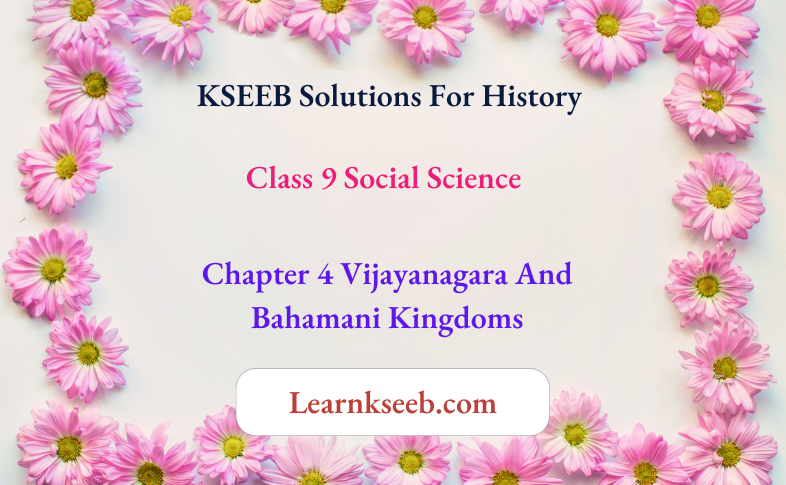
- The ambassador of Persia Abdul Razak recorded that during the Dasara festival, kings from distant places and provincial leaders used to assemble as per the orders of the emperors.
- Alauddin Hasan Gangu Bahman Shah established the Bahamani kingdom in 1347 C.E.
- Mohammad Shah I, Mohammad Shah II, Feroz Shah, Usuf Adil Khan, Ibrahim Adil Shah I, and Ibrahim Adil Shah II were very famous.
- Mohammad Gawan learned Muslim religious verses and law at Kairo, and also gained proficiency in Arab and Parsi languages.
- Divisions of the Bahamani kingdom are Ahamad Nagar (Nijam Shahi), Vijayapura (Adil Shahi), Briar (Emad Shahi), Bidar(Barid Shahi), and Golkonda (Kuthub Shahi)
- Ibrahim Adil Shah II’s book ‘Kitab-E-Navaras’ begins with prayers to the Gods Ganesha, Saraswathi, and Narasimha.
- The Sultan’s cabinet was called Majlis-E-Ilwith. Kotwal, Deshmukh, and Desai were the administrators of the Parganas.
- Gold coins known as ‘hon nu’ and silver coins known as ‘lorry’ and ‘tanka’ were in circulation.
- In Muslim society, Sunni, Shia, Syed, Sheikh, and Pathan are the main groups.
- Mohammad Gawan established a madrasa (college) at Bidar to encourage the study of the Islamic religion and law.
Vijayanagara and Bahamani Kingdoms Class 9 History Notes
Vijayanagara And Bahamani Kingdoms Textual Questions And Answers
Fill in the blanks with suitable words.
- Vijayanagar Empire has established in the year 1336 AD.
- The poetess who wrote Madhuravijaya is Gangadevi.
- Praudhadevaraya’s minister was Lakkanna Dandesha
- The king who wrote Amukta Malyada in Telugu was Krishna Devaraya
- The minister who established famous a madrasa at Bidar was Mohammad Gawan
- The king who wrote Kitab-E-Navarasa was Ibrahim Adil Shah I
Answer the following questions after discussing them in your group.
Question 1. Name the four dynasties which ruled Vijayanagar Empire.
Answer:
The four dynasties that ruled Vijayanagar Empire are:
- Sangama dynasty
- Saluva dynasty
- Tuluva dynasty
- Araveedu dynasty
Question 2. What were the achievements of Devaraya II?
Answer:
The achievements of Devaraya II are:
- Devaraya I had earned the title of “Elephant Hunter’ and “Dakshinapathada Chakravarthi”(the Emperor of the South)
- He defeated king Gajapati Kapilendra of Orissa and seized Kondaveedu.
- He defeated the Kerala ruler and received royalties from Kerala and Sri Lanka.
- He expanded Vijayanagar Empire extending from Sri Lanka to Gulbarga and Telangana to Malabar.
- He chased the traditional foe, Ahmed Shah of Bahamani, till Bijapur and occupied Mudgal and Bankura
- He expanded the kingdom up to the Krishna River in the northeast.
- His commander, Lakkanna Dandesha, took up a successful naval victory.
- The society was based on the four-tiered caste system.
Vijayanagara And Bahamani Kingdoms Class 9 Textbook Solutions
Question 3. What were the problems Krishnadevaraya had to face when he ascended the throne?
Answer: The problems Krishnadevaraya had to face when he ascended the throne were. The Europeans who had arrived through new sea routes were establishing colonies. The Moghuls of the north were trying to expand their Empire in the south. The five Shahi kingdoms of the Bahamani dynasty became powerful Sultanates and plunged into wars against Krishnadevaraya. The kings of Ummatthur and Orissa were a constant source of threat.
Question 4. What are the contributions of the Vijayanagar Empire to the economic system and society?
Answer:
1. Economic System:
- Land tax was the main source of revenue for the kingdom.
- Farmers used to give 4 of their income to the government in the form of tax.
- Professional tax, revenue tax, road tax, market tax, commercial tax, import and export taxes, and tributes from the vassals were the other forms of revenue to the kingdom.
- The Vijayanagar kings constructed wells, tanks, and canals to encourage irrigation and agriculture.
- There were five kinds of practices of land holdings like geni, gutting, siddhaya, vara, and Gadi.
- Spices like pepper, cloves, cardamom, salt Petre, iron ore, diamonds, granulated sugar, musk, sandal perfume, etc. were exported by them.
- There were important textile industries. Coins of different denominations like gold coins,gadyaana, pagoda, silver coins, and copper coins were in use.
2. Social system:
- The society was based on the four-tiered caste system.
- There was also an occupation-based caste system.
- There were many skilled artisans, blacksmiths, goldsmiths, bell-metal smiths, carpenters, weavers, and cobblers in the society.
- The practices of child marriage, sati, and devadasi systems were prevalent.
- Holi, Deepavali, and Dasara festivals were celebrated publicly.
- Dasara festival used to be. celebrated with pomp and glory at Hampi under royal patronage.
Question 5. Describe the art and architecture of the Vijayanagar period.
Answer: The excellent work done by Vijayanagar kings in the fields of art and architecture is memorable. Temples, palaces, forts, towers, huge halls(mahamantapa), public buildings, tanks, bunds, canals, and dams were constructed. The Vijayanagar kings continued the architectural style of Chalukyas, Cholas, and Hoysalas. The unique feature of their architecture was the construction of huge auditorium and marriage halls. Temples had huge towers (rayagopura), leaf-shaped arches, and platforms. Ornamentation, the qualities of grandeur, awe, and elegance were given importance. Rough granite stone (kanashile) was used for the construction of these structures.
Question 6. Who was Mohammad Gawan? What was his contribution to education?
Answer: Mohammad Gawan served as the Prime Minister during the rule of Bahamani kings Humayun, Nizam Shah, and Mohammad Shah IIT. Mohammad Gawan established a madrasa (college) at Bidar to encourage the study of the Islamic religion and law.
Class 9 Social Science Vijayanagara And Bahamani Kingdoms Answers
Question 7. Describe the administration and taxation system during the rule of the Bahamani sultans.
Answer:
1. Administration System:
- There were three levels of administration namely Central, Provincial, and Village.
- There was revenue, judicial and military administration too.
- The Sultan was the chief of the central administration.
- The cabinet was called Majlis-E-Iwith.
- Top officials, commandants, ulemas, and admins were friends and relatives of the Sultan.
- Gawan converted the then-existing four provinces into eight units and these provinces were divided into fifteen Sarkars.
- The Subedar was the administrator in each of these Sarkars.
- Sarakars were divided into paraganas.Kotwal, Deshmukh and Desai were the administrators of the paraganas.
- The final unit of administration was the village having Patel, Kulkarni, and guards as staff.
2. Taxation System:
- The village units were independent units.
- Amir-E-Jumlas were the head of the revenue authorities.
- Land tax was the main source of income for the kingdom.
- 1/2 to 1/3 of the agricultural production was collected as land tax.
- There were 50 kinds of taxes including houses, mines, tobacco, grasslands, trade, and employment.
- The money earned by taxation was used for maintaining palaces, war, and bodyguards, construction, and maintenance of forts.
Question 8. Explain the education, art, and architecture of the Bahamani sultans.
Answer:
1. Education:
- The educational policy of the AdilShahis was to propagate Islamic culture.
- There were schools known as mastabas which were under the control of mosques.
- The students in the mastabas were taught the alphabet, religion, law, poetry, and rhetoric.
- The madrasas were centers of higher education.
- Mohammad Gawan who was a scholar himself, established a madrasa (college) at Bidar to encourage the study of the Islamic religion and law.
- The college was also a lodge for students, teachers, and orthodox people. Astronomy, grammar, mathematics, philosophy, and political science were studied in this college.
2. Art and architecture :
- The Sultans developed the Indo-Saracenic style of architecture.
- The Jamia mosque built by Ali Adil Shah I is a prominent monument even today.
- Ibrahim Roza, Gol Gumbaz, Gagan Mahal, and Asar Mahals are the important monuments of this time.
- These monuments have made the Adil Shahis world famous.
- The Gol Gumbaz at Vijayapura is one of the greatest structures in the world.
Class 9 Social Science Chapter 4 Vijayanagara and Bahamani Notes
Vijayanagara And Bahamani Kingdoms Additional Questions And Answers
Choose the correct alternative and write the complete answer along with its alphabet in the answer sheet provided:
Question 1. The Deccan Sultans united themselves because
- Krishnadevaraya became a more powerful ruler
- Of the progress and prosperity of the Vijayanagara Empire.
- Of the frequent attacks of the Moghuls on the Deccan Sultans
- Mysore, Keladi, and Chitradurga became independent
Answer: 2. Of the progress and prosperity of the Vijayanagara Empire
Question 2. The king who patronaged Ashtha Diggajas was
- Krishnadevaraya
- Devaraya II
- Harihara
- Bukka
Answer: 1. Krishnadevaraya
Question 3. The founder of the Bahamani kingdom was
- Mohammad Shah I
- Mohammad Shah II
- Feroz Shah
- Alauddin Hasan Gangu Baheman Shah
Answer: 4. Alauddin Hasan Gangu Bahman Shah
Vijayanagara And Bahamani Kingdoms Questions And Answers Class 9
Question 4. The main aim of Mohammad’s madrasa at Bidar was
- Providing administration
- Spreading Islamic religion in India
- Encouraging the study of the Islamic religion and law
- Encouraging the study of the Hindu religion and law
Answer: 3. Encouraging study of the Islamic religion and law.
Question 5. Ibrahim Adil Shah II’s book ‘Kitab-E- Navaras’ is a living example for
- Religious synthesis
- Better administration
- Best military system
- Art and Architecture
Answer: 1. Religious synthesis
Question 6. Majlis-E-Ilwith was a
- Gold coin
- Cabinet
- Monument
- Masque
Answer: 2. Cabinet
Vijayanagara And Bahamani Kingdoms Answer the following questions
Question 1. Which were the South Indian kingdoms attacked by Malik Kafer?
Answer:
The South Indian dynasties which were victims of the violence of Allauddin Khilji are:
- The Yadavas of Devagiri
- The Kakatiyas of Warangal
- The Pandyas of Madurai
- Hoysalas of Dwarasamudra (Halebeedu)
- The Cholas of Tanjore
Question 2. Who established Vijayanagara Empire?
Answer: Hakka and Bukka established Vijayanagara Empire on the banks of the Tungabhadra River.
Question 3. When was Vijayanagara Empire established?
Answer: Vijayanagara Empire was established in the year 1336. A:D
Question 4. Who were the famous kings of the Sangama dynasty?
Answer: The famous kings of the Sangama dynasty were Harihara I, Bukkaraya, Harihara II, and Praudhadevaraya.
Question 5. Name the four dynasties that ruled Vijayanagar.
Answer:
The Four Dynasties that ruled Vijayanagar are:
- Sangama dynasty
- Saluva dynasty
- Tuluva dynasty
- Araveedu dynasty
Question 6. Which were the titles earned by DevarayaII?
Answer: Devaraya II (Praudhadevaraya) had earned the title of Elephant Hunter and Dakshinapathada Chakravarthi
Question 7. How did Robert Krishnadevaraya?
Answer: Robert Sewell described Krishnadevaraya that He was an unparalleled warrior, shrewd commander, and political expert.
Class 9 Vijayanagara and Bahamani Kingdoms Short Answers
Question 8. Why was Krishnadevaraya called “Yavanarajya Pratisthapanacharya”?
Answer: Krishnadevaraya defeated the Prime Minister of the Bahamani kingdom, Kasim Barred, and freed the Bahamani prince he had imprisoned and coronated the prince on the Bahamani throne at Bidar and earned the title “Yavanarajya Pratisthapanacharya”.
Question 9. How was the army of Vijayanagara organized?
Answer: Vijayanagar had a mighty army that consisted of three hierarchies of permanent troops, troops sent by vassal states, and troops of royal guards.
Question 10. Which were the festivals celebrated in Vijayanagara?
Answer: Holi, Deepavali, and Dasara festivals were celebrated publicly. Dasara festival used to be celebrated with pomp and glory at Hampi under royal patronage.
Question 11. What were the sources of income for Vijayanagara?
Answer: Professional tax, revenue tax, road tax, market tax, commercial tax, import and. export taxes, and tributes from the vassals were the other forms of revenue to the kingdom.
Question 12. How were the trade and commerce of the Vijayanagara Empire carried out?
Answer: Bhatkal, Honnavara, and Mangaluru were the important ports of Vijayanagar, and foreign traders from Arab, China, and Portugal had trade relations with the Vijayanagar Empire.
Question 13. The Vijaya Vitthala temple of Hampi is a unique temple. Justify.
Answer: The Vijaya Vitthala temple of Hampi is known for its magnificent architectural beauty. The saptaswara musical pillars, huge Kalyana Mantapas, and the Stone Chariot have enhanced the beauty of this temple.
Question 14. Name the famous kings of the Bahamani kingdom
Answer: Mohammad Shah J, Mohammad Shah II, Feroz Shah, Usuf Adil Khan, Ibrahim-Adil Shah I, and Ibrahim Adil Shah I are very famous in the Bahamani kingdom.
Question 15. Which were the major divisions of the Bahamani kingdom?
Answer: Division of the Bahamani kingdom are Ahamad Nagar (Niam Shahi), Vijayapura (Adil Shahi), Briar (Emad Shahi), Bidar (Barid Shahi), and Golkonda (Kuthub Shahi).
Question 16. Which are the main groups in Muslim society?
Answer: Sunni, Shia, Syed, Sheikh, and Pathan are the main groups in Muslim society.
KSEEB Solutions for Class 9 Social Science Karnataka State Syllabus
KSEEB Solutions for Class 9 Social Science History
KSEEB Solutions for Class 9 Social Science Political Science
KSEEB Solutions for Class 9 Social Science Sociology
KSEEB Solutions for Class 9 Social Science Geography
KSEEB Solutions for Class 9 Social Science Economics
KSEEB Solutions for Class 9 Social Science Business Studies


